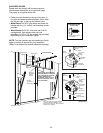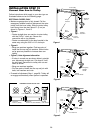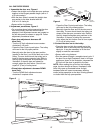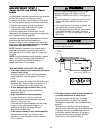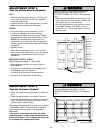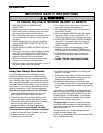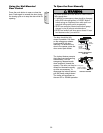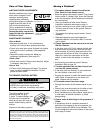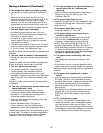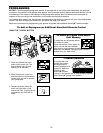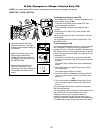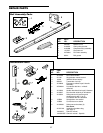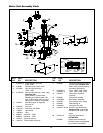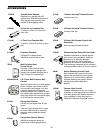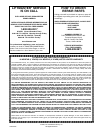
34
Having a Problem? (Continued)
6. The garage door opens and closes by itself:
• Be sure that all remote control push buttons are
off.
• Remove the bell wire from the door control
terminals and operate from the remote only. If this
solves the problem, the door control is faulty
(replace), or there is an intermittent short on the
wire between the door control and the motor unit.
• Clear memory and re-program all remote controls.
7. The door doesn't open completely:
• Is something obstructing the door? Is it out of
balance, or are the springs broken? Remove the
obstruction or repair the door.
• If the door is in good working order but now
doesn't open all the way, increase the up force.
See Adjustment Step 2.
• If the door opens at least 5 feet (1.5 m), the travel
limits may need to be increased. One turn equals
2" (5 cm) of travel. See Adjustment Step 1.
Repeat the safety reverse test after the adjustment is
complete.
8. The door stops but doesn't close completely:
• Review the travel limits adjustment procedures on
page 28.
Repeat the safety reverse test after any adjustment
of door arm length, close force or down limit.
9. The door opens but won't close:
• If the opener lights blink, check the safety
reversing sensor. See Installation Step 10.
• If the opener lights don’t blink and it is a new
installation, check the down force. See Adjustment
Step 2, page 29. For an existing installation, see
below.
Repeat the safety reverse test after the adjustment
is complete.
10. The door reverses for no apparent reason and
opener lights don’t blink:
• Is something obstructing the door? Pull the
emergency release handle. Operate the door
manually. If it is unbalanced or binding, call a
trained door systems technician.
• Clear any ice or snow from the garage floor area
where the door closes.
• Review Adjustment Step 2 on page 29.
• If door reverses in the fully closed position,
decrease the travel limits (Adjustment Step 1).
Repeat safety reverse test after adjustments to force
or travel limits. The need for occasional adjustment
of the force and limit settings is normal. Weather
conditions in particular can affect door travel.
11. The door reverses for no apparent reason and
opener lights blink for 5 seconds after
reversing:
• Check the safety reversing sensor. Remove any
obstruction or align the receiving eye. See
Installation Step 10.
12. The opener lights don't turn on:
• Replace the light bulbs (75 watts maximum). Use a
standard neck garage door opener bulb if regular
bulb burns out.
13. The opener lights don't turn off:
• Is the Light feature on? Turn it off.
14. The opener strains or maximum force is
needed to operate door:
• The door may be out of balance or the springs
may be broken. Close the door and use the
emergency release handle to disconnect the
trolley. Open and close the door manually. A
properly balanced door will stay in any point of
travel while being supported entirely by its springs.
If it does not, disconnect the opener and call a
trained door systems technician. Do not increase
the force to operate the opener.
15. The opener motor hums briefly, then won't
work:
• The garage door springs may be broken. See
above.
• If the problem occurs on the first operation of the
opener, door may be locked. Disable the door lock.
Repeat the safety reverse test after the adjustment is
complete.
16. The opener won't operate due to power
failure:
• Use the emergency release handle to disconnect
the trolley. The door can be opened and closed
manually. When power is restored, press the Door
Control push bar and trolley will automatically
reconnect (unless trolley is in lockout position.)
See page 32.
• The Outside Quick Release accessory (for use on
garages with no service door) disconnects the
trolley from outside the garage in case of power
failure.
17. The chain droops or sags:
• It is normal for the chain to droop slightly in the
closed door position. Use the emergency release
rope and handle to disconnect the trolley. If the
chain returns to the normal height when the trolley
is disengaged, and the door reverses on a 2x4 laid
flat, no adjustments are needed. (See page 11.)



